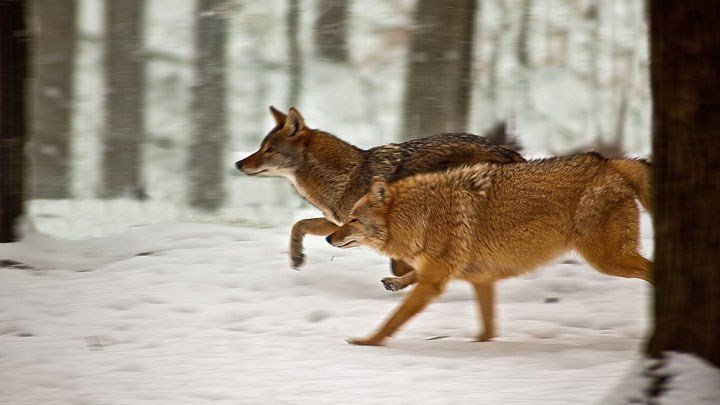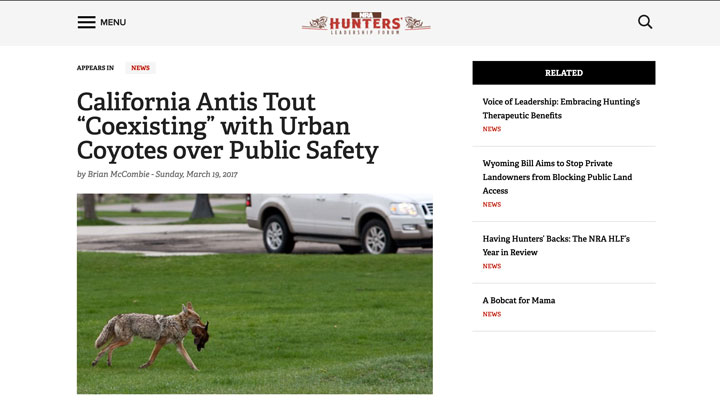
by Brian McCombie - Friday, February 17, 2023

As coyotes continue to expand their ranges across the United States, we see how more conflicts than ever are occurring between these smart predators and people’s pets. Coyotes give farmers and ranchers a major headache, too, with the U.S. Department of Agriculture’s Animal and Plant Health Inspection Service reporting that Wile E. and his mates kill an estimated $115 million annually in livestock. And one scientific study has documented coyotes threatening children (see below). But if you think those problems are confined to Western states or rural areas, think again.
Consider, for example, the lead news story for Feb. 1, 2023, on the Massachusetts Division of Fisheries and Wildlife (MDFW) website: “Coyote Mating Season Is Here: What You Should Know.” Coyotes, the article noted, are found in every city and town in mainland Massachusetts, and the point of the article was not a discussion of coyote biology and reproduction. No, the reason for the article was summed up here: “Seeing or hearing more coyotes lately? You’re not alone. Late January through early March is the mating season for coyotes and they become more active during this time. MDFW officials are reminding the public to take action to prevent conflicts with coyotes with these actionable tips.”
Tip No. 1: Watch out for Fido and Kitty. “During the breeding season, coyotes can become more aggressive toward large-breed dogs, including dogs as large as Labs and shepherds,” the article explains. “Smaller dogs and cats are viewed as prey items by coyotes at any time of the year. Most coyote attacks on pets involve dogs that are off-leash or loose in a backyard.”
But it isn’t only pets. While rare, coyote attacks on human do occur. A recent scientific study published by PLOS BIOLOGY on the topic of large carnivores attacking humans revealed 140 reported coyote attacks on people from 1950 to 2019. More than 90 percent of those attacks were directed at children.
Massachusetts is not the only heavily populated area seeing an influx of ’yotes. These adaptable predators have been spotted in New York City’s Central Park and running free in many California cities including Los Angeles. They are regular inhabitants of major urban areas across Texas and the South, too.
I live in north-central Wisconsin in a small city of some 20,000 people. Recently, a friend of a friend asked if I could help her out with a problem. A pair of coyotes was harassing her black Lab anytime her dog was let into the back yard to do his business. Knowing I am a hunter, and afraid the pair would eventually attack her dog, she asked if I could come over and possibly put down these troubling ’yotes.
I could not, I explained, as her property is within city limits, and using a firearm within city limits is illegal. I forwarded her the MDFW article and suggested she call local ordinance control.
Animal rights extremists have done a very good job of making predator management a controversial issue in many places, as this NRA Hunters’ Leadership Forum (HLF) website (NRAHLF.org) has noted frequently in the past. Yet, scientifically speaking, why should predators like coyotes be exempt from the guidelines followed in the North American Model of Wildlife Conservation (NAMWC), where hunting and trapping are routinely used as effective methods to keep a needed balance between people and wildlife, and between predators and their prey?
There’s no good reason for taking coyotes, mountain lions, wolves and bears out of the NAMWC equation. Yet, again and again, the animal rights extremists and their loud cries against such management have prevailed.
Now, to be clear, no one is talking about wiping out these predators. But management for all wildlife species is needed if sustainable populations are to be maintained for prey and predator species alike. Yet, animal rights extremist groups like the Humane Society of the United States (HSUS) repeatedly target the hunting of predators as something that should never be done.

For example, as far back as 2016 and 2017, NRAHLF.org reported that California extremists, backed by the HSUS, had petitioned Los Angeles officials to keep in place the city’s non-lethal management of problem coyotes—despite “a recent increase in coyote bites on humans, including an attack on a 6-year-old boy … .” A follow-up article in 2018 tracked how California extremists were clinging to their no-kill management solution, preferring residents “learn to co-exist with the predators they have worked so hard to humanize”—even when coyotes pose a threat to people and pets.
Better conservation management of coyotes will not only make Fido and Kitty safer; it will help to strike a better ecological balance between these hardy predators and the wildlife upon which they prey.
About the Author
NRAHLF.org contributor Brian McCombie is a field editor for the NRA’s American Hunter and writes about firearms and gear for the NRA’s Shooting Illustrated. He is a member of the National Rifle Association and the National Shooting Sports Foundation. Brian likes hunting hogs, shooting 1911s chambered in 10mm and .45 ACP, watching the Chicago Bears and relaxing with his two cats, Peanut Morgan and MikaBear.
E-mail your comments/questions about this site to:
[email protected]
